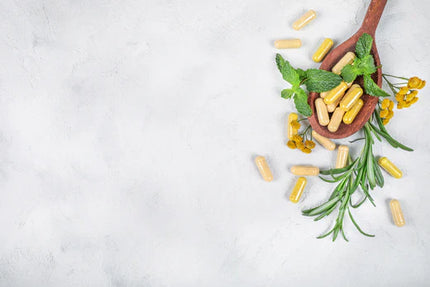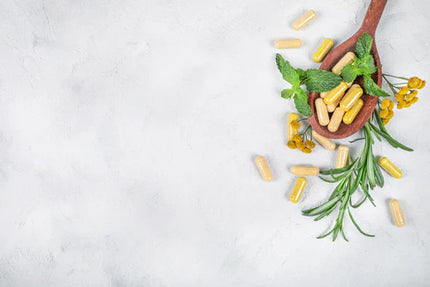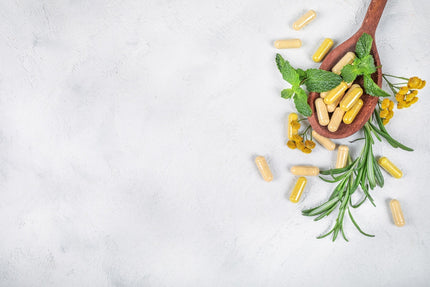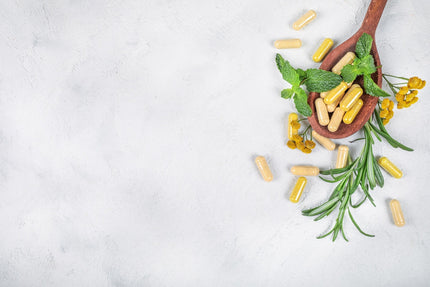Herbs That May Assist
Rehmannia
Rehmannia glutinosa, root dry
Prunella
Prunella vulgaris, flower dry
Lemon balm
Melissa officinalis, leaf dry
Indian gooseberry
Phyllanthus emblica, fruit dry
Actions
- Supports healthy thyroid hormone levels
- Anxiolytic
Clinical Applications
- Hyperthyroidism
Clinical Overview
Hyperthyroidism is defined as a prolonged increase in thyroid hormone production and secretion by the thyroid gland. [1] Graves’ disease is the most common cause of hyperthyroidism, accounting for 60% to 80% of instances. [2] Other causes include toxic multinodular goitre, thyroid adenoma and thyroiditis. [3] Thyrotoxicosis is a general term that refers to the clinical manifestations that arise as a result of persistent elevated levels of free thyroxine (T4) and free triiodothyronine (T3). [4] Common symptoms associated with hyperthyroidism include heat intolerance, hypertension, nervous tension, anxiety, mood changes, difficulty sleeping, and palpitations. [5] Herbal medicines such as rehmannia, prunella, lemon balm and Indian gooseberry have been shown to be useful in the management of hyperthyroidism and its associated symptoms. In particular, rehmannia and lemon balm may aid in alleviating irritability, nervous tension and insomnia, [6],[7] while prunella and Indian gooseberry are beneficial for clearing excess heat. [8],[9] Lemon balm also exerts anxiolytic activity, which is attributed to an elevation of gamma-aminobutyric acid (GABA) levels and occurs via inhibition of GABA transaminase. [10] Additionally, rehmannia and lemon balm have been shown to influence thyroid hormone directly by inhibiting the conversion of T4 to T3, [11],[12] with lemon balm further disrupting TSH binding to its receptor. [13]

Figure 1: Hypothalamic-pituitary-thyroid (HPT) axis. [14]
Background Information
The pathogenesis of hyperthyroidism is contingent upon its aetiology. [15] For instance, in Graves’ disease, an autoimmune process occurs whereby excess production of thyroid hormone is caused by the activation of thyrotropin receptors by thyroid-stimulating antibodies produced within and outside the thyroid gland. The intrathyroidal inflammatory cells also produce cytokines, such as interleukin-1, tumor necrosis factor α, and interferon 󠅢y, that induce the expression of adhesion molecules such as CD54, regulatory molecules, which in turn activate local inflammatory cells. These cytokines also induce thyroid cells to synthesize cytokines that may help sustain the intrathyroidal autoimmune process [16] (Figure 2).
In the case of toxic multinodular goitre, thyroid epithelial cell proliferation and mutations occur. [17] These mutations represent a repair mechanism, however accumulate as a result of being unable to keep up with the rate of thyroid epithelial replication. [18] Somatic mutations in the thyroid stimulating hormone receptor, as seen in the formation of autonomous hyperfunctioning nodules, may also arise. [19] The development of toxic thyroid adenomas occurs via much the same process. [20]
Thyroiditis is a term used to describe a collection of disorders that involve inflammation of the thyroid gland. [21] Subacute thyroiditis is most commonly associated with hyperthyroidism and is regarded as a form of post-viral thyroid inflammation. [22] It has been hypothesised that an antigen produced by the viral infection binds to human leukocyte antigen (HLA) molecules on macrophages, activating cytotoxic T-lymphocytes, which then destroy thyroid follicular cells. [23]
Regardless of the cause of hyperthyroidism, the clinical manifestations largely remain the same [24] with several traditional herbs having been shown to be beneficial in hyperthyroid conditions.

Figure 2: Pathogenesis of Graves’ disease. [25]
Rehmannia glutinosa (rehmannia) is used in traditional Chinese medicine (TCM) for conditions that features heat and irritability. [26] It is thought to nourish yin and revitalise the kidney. [27]
In TCM, Prunella vulgaris (prunella) flower has a history of use for clearing heat and dissipating neck nodules. [28] Intriguingly, research has shown that prunella softens hard lumps and dissipates stagnation, and hence may be useful for the attenuation of goitre, a common occurrence in individuals with hyperthyroidism. [29] The antiproliferative effects of prunella have also been explored for its potential inclusion as part of an effective treatment of cancer, including thyroid cancer. [30]
Another herb with a long history of use in TCM is Phyllanthus emblica (Indian gooseberry), a cooling herb, used to address heat states. [31]
Lemon balm leaf possesses several traditional Western herbal applications relevant to hyperthyroidism, most notably for the treatment of nervous tension, as a diaphoretic, [32] and for nervous sleeping disorders. [33]
Actions
Supports Healthy Thyroid Hormone Levels
In Western herbal medicine, rehmannia has demonstrated regulating effects on abnormal thyroid hormone levels, [34] which are understood to occur via a lowering of peripheral conversion of T4 to T3. [35] Similarly, extracts from lemon balm have been shown in vitro to inhibit extrathyroidal conversion of T4 to T3, indicating a potential benefit for hyperthyroidism. [36] Indian gooseberry has also been shown to ameliorate hyperthyroidism by reducing T3 and T4 concentrations. [37]
Another important finding comes from in vitro studies that have revealed lemon balm to disrupt thyroid signalling. By blocking the binding of TSH and TSH receptor antibodies to the human TSH receptor, the production of thyroid hormones is subsequently inhibited. [38],[39] This is of particular importance with respect to Graves’ disease. [40]
Anxiolytic
As previously noted, anxiety and mood changes are frequent occurrences among individuals with hyperthyroidism. [41] Rehmannia may help to address these symptoms as it has demonstrated significant inhibitory activity on the central nervous system, [42] which is thought to be due to an anti-inflammatory action. Cytokine signalling in the brain is known to regulate important brain functions including neurotransmitter metabolism, neuroendocrine function, synaptic plasticity, as well as the neural circuitry of mood. Catalpol, an iridoid glycoside from the roots of rehmannia [43] attenuates lipopolysaccharide (LPS)-induced inflammation and subsequent microglial activation and dopaminergic neurotoxicity. [44] It is through this mechanism rehmannia is thought to exert an inhibitory action on the nervous system. [45]
Rosmarinic acid (RA) is a major phenolic constituent of both prunella [46] and lemon balm. [47] In vitro and in vivo studies of lemon balm have shown significant inhibition of GABA transaminase, an enzyme that metabolises GABA, resulting in an increase in brain GABA levels. [48] Components of lemon balm have also been shown in vitro and in vivo to potentiate the response of GABA type A receptors (GABAARs) via allosteric modulation and/or by agonist effect. [49]
Clinical Applications
Hyperthyroidism
The clinical benefits of lemon balm in hyperthyroidism have been demonstrated in a randomised, placebo-controlled, double-blind, crossover study. [50] Twenty healthy young adults received single doses of 600 mg/d, 1000 mg/d, and 1600 mg/d of encapsulated dried leaf, or matching placebo at seven-day intervals. Cognitive performance and mood were assessed. [51] The most notable effects were improved memory performance for the 1600 mg/d dose (p=0.006) and increased ‘calmness’ for both the 1000 mg/d and 1600 mg/d doses; although effects were more sustained for the highest dose (p=0.027). [52]
Another double-blind, randomised, placebo-controlled trial assessed the efficacy of lemon balm in alleviating benign palpitations in anxious patients. [53] Over 14 days, 55 patients received either 500 mg/d of lemon balm twice daily, or placebo. [54] At the completion of the trial, those who received the lemon balm experienced a reduction in the frequency of palpitations (p=0.004) compared to those receiving placebo. [55]
Lemon balm has also demonstrated a capacity to alleviate the negative effects of stress. [56] In a randomised, double-blind, placebo-controlled, crossover trial, eighteen participants were exposed to laboratory-induced stress, assessed via the Defined Intensity Stressor Simulation (DISS) battery. [57] Participants then received a 300 mg/d and 600 mg/d dose of a standardised methanolic extract of lemon balm, separated by 7 days. The 600 mg/d dose was found to improve mood as measured by the DISS, in addition to increased calmness and reduced alertness. [58]
Similar findings emerged from a prospective open-label pilot study of stressed individuals with mild to moderate anxiety disorders and sleep disturbances. [59] The subjects received a standardised extract of lemon balm at a dose of 600 mg/d (300 mg/d twice daily) for 15 days. [60] At the conclusion of the study, there was an 18% reduction in anxiety manifestations (p<0.01), 15% reduction in anxiety-associated symptoms (p<0.01), and 42% reduction in insomnia (p <0.01). [61]
Symptoms of hyperactivity and irritability can also be significantly debilitating in hyperthyroidism, with rehmannia shown to exert sedative effects in an animal model. [62] In one study, excitement was induced in mice by caffeine sodium benzoate with supplementation of an aqueous extract of rehmannia demonstrating antagonistic effects: supporting its sedative action. [63]
Indian gooseberry has been shown to be effective in reducing hypertension, another associated symptom of hyperthyroidism. In an uncontrolled human study, Indian gooseberry elicited anti-hypertensive effects. [64] The study involved 10 days of treatment with Indian gooseberry in 9 hypertensive individuals, which resulted in a significant reduction in systolic blood pressure. [65]
The potential ameliorating effects of Indian gooseberry on thyroxine-induced hyperthyroidism in mice has also been investigated. [66] The mice were given oral administration of Indian gooseberry at a dose of 250 mg/kg/d or a standard antithyroid drug, propyl thiouracil (PTU) for 30 days. [67] In the Indian gooseberry treated mice, T3 and T4 concentrations were reduced by 64% and 70% respectively, in contrast to the PTU treated mice where reductions of T3 and T4 levels were 59% and 40% respectively. [68] These studies help to substantiate the use of herbal medicines in the management of hyperthyroid conditions and their associated symptoms.
Safety Information
Disclaimer: In the interest of supporting health Practitioners, all safety information provided at the time of publishing (Oct 2025) has been checked against authoritative sources. Please note that not all interactions have been listed.
For further information on specific interactions with health conditions and medications, refer to clinical support on 1800 777 648(AU), 0508 227 744(NZ) or via email, anz_clinicalsupport@metagenics.com, or via Live Chat www.metagenics.com.au, www.metagenics.co.nz
Pregnancy
- No risks found in humans with the use of Rehmannia, Prunella, Lemon balm or Amla. although research is limited or unavailable.
Breastfeeding
- Appropriate for use, although research is limited or unavailable.
Contraindications
- Allergies and sensitivities: Avoid in individuals with known allergy or hypersensitivity to the Lamiaceae (mint) family, which includes Prunella and Lemon balm.
- Hypothyroidism: Lemon balm may reduce thyroid hormone levels and alter thyroid function. Therefore, it is recommended to avoid in states of hypothyroidism.
Cautions
- Anticoagulant/antiplatelet drugs: Theoretically, Amla may increase the risk of bleeding if used with anticoagulant or antiplatelet drugs, however research is conflicting.
- Antidiabetic drugs: Taking Amla and/or Rehmannia with antidiabetic drugs might increase the risk of hypoglycaemia.
- Antihypertensive drugs: Theoretically, rehmannia might increase the risk of hypotension when taken with antihypertensive drugs.
- CNS depressants: Theoretically, concomitant use of Lemon balm might have additive effects with CNS depressant drugs.
- Thyroid Hormone: Theoretically, lemon balm might interfere with thyroid hormone replacement therapy.
References
[1] Singh I, Hershman JM. Pathogenesis of hyperthyroidism. Compr Physiol. 2016 Dec 6;7(1):67-79.
[2] Singh I, Hershman JM. Pathogenesis of hyperthyroidism. Compr Physiol. 2016 Dec 6;7(1):67-79.
[3] Vanderpump MP. The epidemiology of thyroid disease. Br Med Bull. 2011;99:39-51.
[4] Singh I, Hershman JM. Pathogenesis of hyperthyroidism. Compr Physiol. 2016 Dec 6;7(1):67-79.
[5] Singh I, Hershman JM. Pathogenesis of hyperthyroidism. Compr Physiol. 2016 Dec 6;7(1):67-79.
[6] Kennedy DO, Wake G, Savelev S, Tildesley NT, Perry EK, Wesnes KA, et al. Modulation of mood and cognitive performance following acute administration of single doses of Melissa officinalis (Lemon balm) with human CNS nicotinic and muscarinic receptor-binding properties. Neuropsychopharm. 2003 Oct;28(10): 1871–1881.
[7] Bensky D, Gamble A, Kaptchuk T. Rehmannia: Chinese herbal medicine materia medica. Eastland Press; 1993. p. 68-69.
[8] Bensky D, Gamble A, Kaptchuk T. Rehmannia: Chinese herbal medicine materia medica. Eastland Press; 1993. p. 68-69.
[9] Pole S. Ayurvedic medicine: The principles of traditional practice. Philadelphia: Elsevier/Churchill Livingstone; 2006. p. 143-144.
[10] Awad R, Levac D, Cybulska P, Merali Z, Trudeau VL, Arnason JT. Effects of traditionally used anxiolytic botanicals on enzymes of the gamma-aminobutyric acid (GABA) system. Can.J. Physiol.Pharmacol 2007. 85:933-942.
[11] Braun L, Cohen M. Zinc: In herbs and natural supplements, an evidence based guide. 3 rd ed. Churchill Livingstone; 2010. p. 1037-1054.
[12] Duntas LH. Selenium and the thyroid: a close-knit connection. J Clin Endocrinol and Metab. 2010 Dec;95(12): 5180-5188.
[13] Duntas LH. Selenium and the thyroid: a close-knit connection. J Clin Endocrinol and Metab. 2010 Dec;95(12): 5180-5188.
[14]Geoface. Hypothalamic-pituitary-thyroid axis [Internet]. 2016 [updated 2016 Aug 14; cited 2018 Apr 23]. Available from: http://geoface.info/cbeb/e5578888e08e/surgery-on-the-hypothalamus-hypothalamic-pituitary-thyroid-axis-efe614
[15] Singh I, Hershman JM. Pathogenesis of hyperthyroidism. Compr Physiol. 2016 Dec 6;7(1):67-79.
[16] Weetman AP. Graves' disease. N Engl J Med. 2000 Oct 26;343(17):1236-48.
[17] Singh I, Hershman JM. Pathogenesis of hyperthyroidism. Compr Physiol. 2016 Dec 6;7(1):67-79.
[18] Singh I, Hershman JM. Pathogenesis of hyperthyroidism. Compr Physiol. 2016 Dec 6;7(1):67-79.
[19] Singh I, Hershman JM. Pathogenesis of hyperthyroidism. Compr Physiol. 2016 Dec 6;7(1):67-79.
[20] Singh I, Hershman JM. Pathogenesis of hyperthyroidism. Compr Physiol. 2016 Dec 6;7(1):67-79.
[21] Singh I, Hershman JM. Pathogenesis of hyperthyroidism. Compr Physiol. 2016 Dec 6;7(1):67-79.
[22] Singh I, Hershman JM. Pathogenesis of hyperthyroidism. Compr Physiol. 2016 Dec 6;7(1):67-79.
[23] Singh I, Hershman JM. Pathogenesis of hyperthyroidism. Compr Physiol. 2016 Dec 6;7(1):67-79.
[24] Singh I, Hershman JM. Pathogenesis of hyperthyroidism. Compr Physiol. 2016 Dec 6;7(1):67-79.
[25] Weetman AP. Graves' disease. N Engl J Med. 2000 Oct 26;343(17):1236-48.
[26] Bensky D, Gamble A, Kaptchuk T. Rehmannia: Chinese herbal medicine materia medica. Eastland Press; 1993. p. 68-69.
[27] Zhang RX, Li MX, Jia ZP. Rehmannia glutinosa: review of botany, chemistry and pharmacology. J Ethnopharmacol. 2008 May 8;117(2):199-214.
[28] Bensky D, Gamble A, Kaptchuk T. Rehmannia: Chinese herbal medicine materia medica. Eastland Press; 1993. p. 59-60.
[29] Ba Y, Wang Y. Content determination in Prunella vulgaris L. and its anti-proliferative effect on thyroid cancer cells. Biomedical Research. 2017;28(8):3427-3432.
[30] Ba Y, Wang Y. Content determination in Prunella vulgaris L. and its anti-proliferative effect on thyroid cancer cells. Biomedical Research. 2017;28(8):3427-3432.
[31] Pole S. Ayurvedic medicine: The principles of traditional practice. Philadelphia; Elsevier/Churchill Livingstone; 2006. p. 143-144.
[32] Bone K. A clinical guide to blending liquid herbs. St Louis, Missouri: Elsevier/Churchill Livingstone; 2003. p. 308-311.
[33] Blumenthal M, Senior Editor. The complete German commission E monographs. Therapeutic guide to herbal medicines. Texas; American Botanical Council, 1998: p.160-161.
[34] Zhang RX, Li MX, Jia ZP. Rehmannia glutinosa: review of botany, chemistry and pharmacology. J Ethnopharmacol. 2008 May 8;117(2):199-214.
[35] Shan JC. Determination of hepatocyte adrenergic alpha 1 receptor and study on actions of nourishing yin and replenishing qi drugs in experimental hyperthyroid rats. Zhongguo Zhong Xi Yi Jie He Za Zhi. 1994 Feb;14(2):96-8, 69-70.
[36] Auf'mkolk M, Ingbar JC, Kubota K, Amir SM, Ingbar SH. Extracts and auto-oxidized constituents of certain plants inhibit the receptor-binding and the biological activity of Graves' immunoglobulins. Endocrinol. 1985;116(5):1687-93.
[37] Panda S, Kar A. Fruit extract of Emblica officinalis ameliorates hyperthyroidism and hepatic lipid peroxidation in mice. Pharmazie. 2003 Oct;58(10):753-5.
[38] Santini F, Vitti P, Ceccarini G, Mammoli C, Rosellini V, Pelosini C, et al. In vitro assay of thyroid disruptors affecting TSH-stimulated adenylate cyclase activity. J Endocrinol Invest 2003;26(10):950-5.
[39] Auf'mkolk M, Ingbar JC, Kubota K, Amir SM, Ingbar SH. Extracts and auto-oxidized constituents of certain plants inhibit the receptor-binding and the biological activity of Graves' immunoglobulins. Endocrinology 1985;116(5):1687-93.
[40] Auf'mkolk M, Ingbar JC, Kubota K, Amir SM, Ingbar SH. Extracts and auto-oxidized constituents of certain plants inhibit the receptor-binding and the biological activity of Graves' immunoglobulins. Endocrinol. 1985;116(5):1687-93.
[41] Singh I, Hershman JM. Pathogenesis of hyperthyroidism. Compr Physiol. 2016 Dec 6;7(1):67-79.
[42] Zhang RX, Li MX, Jia ZP. Rehmannia glutinosa: review of botany, chemistry and pharmacology. J Ethnopharmacol. 2008 May 8;117(2):199-214.
[43] Tian YY, An LJ, Jiang L, Duan YL, Chen J, Jiang B. Catalpol protects dopaminergic neurons from LPS-induced neurotoxicity in mesencephalic neuron-glia cultures. Life Sci. 2006 Dec 23;80(3):193-9.
[44] Zhang RX, Li MX, Jia ZP. Rehmannia glutinosa: review of botany, chemistry and pharmacology. J Ethnopharmacol. 2008 May 8;117(2):199-214.
[45] Glass CK, Saijo K, Winner B, Marchetto MC, Gage FH. Mechanisms underlying inflammation in neurodegeneration. Cell. 2010 Mar 19;140(6):918-34.
[46] Bai Y, Xia B, Xie W, Zhou Y, Xie J, Li H, et al. Phytochemistry and pharmacological activities of the genus Prunella. Food Chem. 2016 Aug 1;204:483-96.
[47] Pereira P, Tysca D, Oliveira P, da Silva Brum LF, Picada JN, Ardenghi P. Neurobehavioral and genotoxic aspects of rosmarinic acid. Pharmacol Res 2005;52(3):199-203.
[48] Awad R, Levac D, Cybulska P, Merali Z, Trudeau VL, Arnason JT. Effects of traditionally used anxiolytic botanicals on enzymes of the gamma-aminobutyric acid (GABA) system. Can J Physiol Pharmacol 2007;85(9):933-42.
[49] Pineau S, Legros C, Mattei C. The medical use of lemon balm (Melissa officinalis) and valerian (Valeriana officinalis) as natural sedatives: insight into their interactions with GABA transmission. Int J Clin Pharmacol Pharmacother. 2016: 1(112).
[50] Kennedy DO, Wake G, Savelev S, Tildesley NT, Perry EK, Wesnes KA, et al. Modulation of mood and cognitive performance following acute administration of single doses of Melissa officinalis (Lemon balm) with human CNS nicotinic and muscarinic receptor-binding properties. Neuropsychopharm. 2003 Oct;28(10): 1871–1881.
[51] Kennedy DO, Wake G, Savelev S, Tildesley NT, Perry EK, Wesnes KA, et al. Modulation of mood and cognitive performance following acute administration of single doses of Melissa officinalis (Lemon balm) with human CNS nicotinic and muscarinic receptor-binding properties. Neuropsychopharm. 2003 Oct;28(10): 1871–1881.
[52] Kennedy DO, Wake G, Savelev S, Tildesley NT, Perry EK, Wesnes KA, et al. Modulation of mood and cognitive performance following acute administration of single doses of Melissa officinalis (Lemon balm) with human CNS nicotinic and muscarinic receptor-binding properties. Neuropsychopharm. 2003 Oct;28(10): 1871–1881.
[53] Alijaniha F, Naseri M, Afsharypuor S, Fallahi F, Noorbala A, Mosaddegh M, et al. Heart palpitation relief with Melissa officinalis leaf extract: double blind, randomized, placebo controlled trial of efficacy and safety. J Ethnopharmacol. 2015 Apr 22;164:378-84.
[54] Alijaniha F, Naseri M, Afsharypuor S, Fallahi F, Noorbala A, Mosaddegh M, et al. Heart palpitation relief with Melissa officinalis leaf extract: double blind, randomized, placebo controlled trial of efficacy and safety. J Ethnopharmacol. 2015 Apr 22;164:378-84.
[55] Alijaniha F, Naseri M, Afsharypuor S, Fallahi F, Noorbala A, Mosaddegh M, et al. Heart palpitation relief with Melissa officinalis leaf extract: double blind, randomized, placebo controlled trial of efficacy and safety. J Ethnopharmacol. 2015 Apr 22;164:378-84.
[56] Shakeri A, Sahebkar A, Javadi B. Melissa officinalis L. A review of its traditional uses, phytochemistry and pharmacology. J Ethnopharmacol. 2016 Jul 21;188:204-28.
[57]Shakeri A, Sahebkar A, Javadi B. Melissa officinalis L. A review of its traditional uses, phytochemistry and pharmacology. J Ethnopharmacol. 2016 Jul 21;188:204-28.
[58]Shakeri A, Sahebkar A, Javadi B. Melissa officinalis L. A review of its traditional uses, phytochemistry and pharmacology. J Ethnopharmacol. 2016 Jul 21;188:204-28.
[59] Shakeri A, Sahebkar A, Javadi B. Melissa officinalis L. A review of its traditional uses, phytochemistry and pharmacology. J Ethnopharmacol. 2016 Jul 21;188:204-28.
[60] Shakeri A, Sahebkar A, Javadi B. Melissa officinalis L. A review of its traditional uses, phytochemistry and pharmacology. J Ethnopharmacol. 2016 Jul 21;188:204-28.
[61] Shakeri A, Sahebkar A, Javadi B. Melissa officinalis L. A review of its traditional uses, phytochemistry and pharmacology. J Ethnopharmacol. 2016 Jul 21;188:204-28.
[62] Zhang RX, Li MX, Jia ZP. Rehmannia glutinosa: review of botany, chemistry and pharmacology. J Ethnopharmacol. 2008 May 8;117(2):199-214.
[63] Zhang RX, Li MX, Jia ZP. Rehmannia glutinosa: review of botany, chemistry and pharmacology. J Ethnopharmacol. 2008 May 8;117(2):199-214.
[64] Srividya N, Periwal S. Diuretic, hypotensive and hypoglycaemic effect of Phyllanthus amarus. Indian J Exp Biol. 1995;33(11):861-4.
[65] Srividya N, Periwal S. Diuretic, hypotensive and hypoglycaemic effect of Phyllanthus amarus. Indian J Exp Biol. 1995;33(11):861-4.
[66]Panda S, Kar A. Fruit extract of Emblica officinalis ameliorates hyperthyroidism and hepatic lipid peroxidation in mice. Pharmazie. 2003 Oct;58(10):753-5.
[67]Panda S, Kar A. Fruit extract of Emblica officinalis ameliorates hyperthyroidism and hepatic lipid peroxidation in mice. Pharmazie. 2003 Oct;58(10):753-5.
[68] Panda S, Kar A. Fruit extract of Emblica officinalis ameliorates hyperthyroidism and hepatic lipid peroxidation in mice. Pharmazie. 2003 Oct;58(10):753-5.




